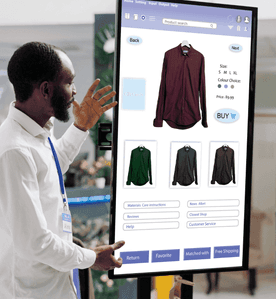Do You Know Ideas Aren’t to Be Funded, But MVPs Are?
Sector: Digital Product
Author: Nisarg Mehta
Date Published: 03/14/2023

Contents
Getting seed funding is the most challenging part of a startup journey. And what’s more challenging is that entrepreneurs believe that every idea they come up with is worth millions.
As entrepreneurs, they may believe their ideas are unique and hope to secure funding for their startups. However, they often overlook the fact that investors may not be familiar with the idea and are primarily interested in the final product’s usefulness.
Therefore, it’s crucial to keep the end user’s perspective in mind when seeking initial investment for a business idea.
Let’s understand why it’s hard to get funding at the ideation state.
Why Ideas Are Hardly Funded
It’s generally hard to secure funding at the ideation stage because, at this point, the business idea is just a concept or a vision, and there is often little to no tangible evidence that the idea will be successful.
Here are the reasons why entrepreneurs find it hard to raise money at the ideation state:
Lack of Evidence
At the ideation stage, there is often little to no tangible evidence that the business idea will be successful. Instead, investors typically look for startups that have a viable business model and a clear plan of execution, backed up by some evidence of market demand. Without any of these factors, it can be challenging to convince investors to park their money in the idea.
High Risk
Investing in an idea that has no tangible product or prototype is risky for investors. Without a working product or prototype, the chances of success are uncertain, and the risks are high. Investors want to see some level of validation and proof of concept (POC) before they invest their money.
Unknown Market
At the ideation stage, the market demand for the product or service is often unknown. Without market validation or research, investors are usually skeptical about the potential for success and are hesitant to invest. Investors want to see that there is a real need for the product or service and that customers are willing to pay for it.
Lack of Team
It is more likely that the startup does not have a team in place at the ideation state. Investors would prefer investing in a startup with a strong team with the necessary skills and experience to execute the business plan successfully. Without a solid team in place, it can be challenging to convince investors to invest in the idea.
Competing Ideas
Saving the best reason for the last – in today’s startup landscape, there are likely to be several competing ideas that are trying to solve similar problems. Investors will often consider multiple ideas and choose the one they believe has the best potential for success. This means that startups at the ideation stage need to stand out and offer more than just an idea.
In summary, at the ideation stage, startups face several challenges that can make it difficult to secure funding. To increase their chances of success, startups need to have a viable business model, a clear plan of execution, and some evidence of market demand. They also need to have a strong team in place and offer a unique solution to a problem to stand out from competing ideas.
And, in order to have all this, building an MVP is the best foot forward.
Why? Let’s discuss the examples of MVPs that brought investments.
On the Other Hand, MVPs Do Bring Investment
Gartner says, “An MVP is a product with just enough features and functionalities to satisfy early customers and provide feedback for future product development.”
In other words, an MVP is a version of a product or service that has enough essential features to meet the needs of early adopters while also allowing the development team to gather feedback and make improvements for future versions.
The goal of an MVP is to create a functional product that can be tested and validated with customers without investing too much time or money upfront in developing features that may not be necessary or desired. This approach allows startups to validate their assumptions, learn from customer feedback, and, most importantly, impress investors.
Uber MVP Success
For example, when the Uber app idea came into the picture, there were already existing taxi services which meant the market demand was already proven. Moreover, Uber’s MVP was a mobile app that allowed users to request a ride and track the driver’s location in real-time. This technology was innovative, and the app’s seamless user experience made it stand out from traditional taxi services.
Still, Uber’s first investment came in early 2010, which was after the development of their Minimum Viable Product (MVP) and the launch of their app.
Uber secured $1.25 million in seed funding from several investors, including First Round Capital, Lowercase Capital, and angel investor Chris Sacca. This funding helped Uber to expand further and improve its app’s features and user experience, ultimately leading to its successful growth and dominance in the ride-sharing market.
The moral of the story is that with their MVP, Uber was able to demonstrate their idea’s potential and scalability, which helped them secure funding from investors. The company has since grown to become one of the most successful startups globally, with a valuation of about $70 billion.
Wefarm MVP Success
Another example is Wefarm, a peer-to-peer knowledge-sharing platform for small-scale farmers. The startup launched its MVP in 2015 and began testing its product in Kenya. The MVP allowed farmers to ask questions and receive answers (via SMS) from other farmers, even if they didn’t have access to the internet. Wefarm’s MVP was successful, with over 3,000 farmers joining the platform in just a few months.
In 2016, Wefarm raised $1.6 million in seed funding, led by True Ventures and LocalGlobe, after its MVP launch. The funding allowed the startup to expand its platform to other countries and develop new features, such as a machine learning-powered recommendation engine that provides personalized advice to farmers.
Wefarm’s success demonstrates the importance of launching an MVP to validate assumptions, test the product with customers, and attract funding from investors.
Why are Funding Possibilities Marvelous with MVPs?
Investors often prefer to invest in Minimum Viable Products (MVPs) over just an idea or concept because MVPs provide a level of tangibility that can make the product or service more attractive and less risky for investors.
The following are some of the reasons why investors love to invest in MVPs:
Validation of Product Market Fit
MVPs allow startups to test their assumptions and validate product-market fit by launching a working product or service that has been tested with potential customers. This provides evidence that the startup has a viable product that customers are willing to use, which can make it more attractive to investors.
Lower Risk
MVPs are developed quickly and cheaply, with only the essential features needed to meet the needs of early adopters. This reduces the risk for investors, as the startup is not investing too much money upfront in developing features that may not be necessary or desired.
Early Feedback
MVPs allow startups to gather customer feedback early on in the development process. This can be valuable for investors, as they can see how the startup is responding to customer feedback and making improvements to the product or service. Early feedback can also help startups avoid costly mistakes later on.
Faster Time to Market
MVPs allow startups to launch their product or service quickly, often in just a few months. It is because startups can keep adding new features and services to their MVPs one by one. This can be appealing to investors who want to see a return on their investment quickly.
Demonstrate Market Demand
By launching an MVP, startups can validate their assumptions and test the market demand for their product or service. This provides evidence that customers are willing to pay for the product or service, which can make it more attractive to investors.
Flexibility
MVPs are designed to be flexible, allowing startups to make changes to the product or service based on feedback from customers. This can be attractive to investors, as it shows that the startup is responsive to customer needs and can adapt quickly to changes in the market.
Cost-Effectiveness
MVPs are typically developed at a lower cost than a fully-featured product, which can entice investors who want to see the startup spend their capital wisely. This can help to reduce the startup’s burn rate and increase its runway, which can be important for securing future funding.
To summarize, MVPs are attractive to investors because they allow startups to validate product-market fit, gather early feedback, and demonstrate market demand while also reducing risk and allowing for flexibility and cost-effectiveness.
How to Move from Idea to MVP
To move from a business idea to an MVP, startups should follow a series of steps. Here is how you can realize the benefits of MVP:
Conduct Market Research
Before developing an MVP, startups should conduct market research to ensure that there is a need for their product or service in the market. This involves gathering information about the target market, including customer needs, preferences, and behaviors.
Let’s say you want to develop a mobile app for pet owners. Before developing the app, you should research the market to gather information about pet owners’ needs and preferences. This could involve surveys, focus groups, or interviews with potential customers.
Develop a Minimum Viable Product
Once market research has been completed, startups should develop an MVP that includes only the essential features needed to meet the needs of early adopters. This allows the startup to launch a working product quickly and inexpensively.
Continuing with the pet app example, you might develop an MVP that includes features such as a pet profile, a list of local pet-friendly businesses, and a feature to book appointments with pet groomers. The MVP should be functional and user-friendly. However, it should only include the minimum features necessary to provide value to early adopters.
Test and Refine the MVP
After the MVP is developed, startups should test it with potential customers to gather feedback and improve. This involves iterating on the MVP until it meets customers’ needs and provides a compelling value proposition.
For your pet app startup, you can test the app MVP with a group of pet owners to gather feedback on its functionality and usefulness. Based on this feedback, you can make changes to the app, such as adding a feature to track pet vaccinations or a social feature to connect with other pet owners.
Secure Funding
Once the MVP has been developed and refined, startups can seek funding to scale their product or service. This can involve pitching to investors, applying for grants or loans, or crowdfunding.
For your pet app startup, you should seek funding from investors to scale their product and reach more pet owners. Prepare a pitch deck that outlines their MVP, market research, and growth plans, and present this to potential investors to secure funding.
Conclusion
It is critical to note that not all ideas are million-dollar ones, and startups should be realistic about the potential of their product or service. By focusing on developing an MVP and testing it with customers, startups can gather feedback and make improvements to ensure that their product has the best chance of success.
Investors are more likely to invest in MVPs because they are tangible and provide evidence of the startup’s potential. By launching an MVP, startups can demonstrate that they have a viable business model, a deep understanding of their target market, and a product that meets the needs of early adopters.
Moreover, startups should have a clear plan of action and a business strategy when it comes to scaling up the MVP. When they’ve gathered enough customer feedback, it’s time to roll out new features and embark on their journey to a full-fledged product.



